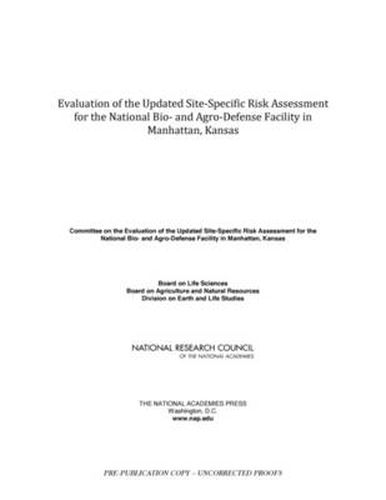Readings Newsletter
Become a Readings Member to make your shopping experience even easier.
Sign in or sign up for free!
You’re not far away from qualifying for FREE standard shipping within Australia
You’ve qualified for FREE standard shipping within Australia
The cart is loading…






Safeguarding U.S. agriculture from foreign animal diseases and protecting our food system require cutting-edge research and diagnostic capabilities. The Department of Homeland Security (DHS) and the U.S. Department of Agriculture (USDA) have embarked on an important mission to replace the aging Plum Island Animal Disease Center (PIADC) with a new facility, the National Bio- and Agro-Defense Facility (NBAF). When operational, this new facility would be the world’s fourth biosafety level-4 laboratory capable of large animal research. It would serve as a critical world reference laboratory for identifying emerging and unknown disease threats, and would thus be a critical asset in securing the future health, wealth, and security of the nation.
DHS selected Manhattan, Kansas, as the site for the new NBAF after an extensive site-selection process that involved an environmental impact statement. The Government Accountability Office (GAO) raised concerns about DHS’s analysis of the potential spread of foot-and-mouth disease virus (FMDv), one of the most serious foreign animal disease threats. Congress directed DHS to conduct a site-specific risk assessment (SSRA) for the NBAF, instructed the National Research Council (NRC) to independently evaluate the SSRA, and prohibited obligation of NBAF construction funds until the NRC review was complete.
Congress mandated that DHS revise its SSRA to address shortcomings of the 2010 SSRA, directed the NRC to evaluate the updated SSRA (uSSRA), and again prohibited obligation of construction funds until the completion of the second review. The scope for both of these SSRA reports addressed accidental release of pathogens from the NBAF in Manhattan, Kansas and excluded terrorist acts and malicious threats from its risk assessments. Evaluation of the Updated Site-Specific Risk Assessment for the National Bio- and Agro-Defense Facility in Manhattan, Kansas is the evaluation of the final uSSRA.
$9.00 standard shipping within Australia
FREE standard shipping within Australia for orders over $100.00
Express & International shipping calculated at checkout
Safeguarding U.S. agriculture from foreign animal diseases and protecting our food system require cutting-edge research and diagnostic capabilities. The Department of Homeland Security (DHS) and the U.S. Department of Agriculture (USDA) have embarked on an important mission to replace the aging Plum Island Animal Disease Center (PIADC) with a new facility, the National Bio- and Agro-Defense Facility (NBAF). When operational, this new facility would be the world’s fourth biosafety level-4 laboratory capable of large animal research. It would serve as a critical world reference laboratory for identifying emerging and unknown disease threats, and would thus be a critical asset in securing the future health, wealth, and security of the nation.
DHS selected Manhattan, Kansas, as the site for the new NBAF after an extensive site-selection process that involved an environmental impact statement. The Government Accountability Office (GAO) raised concerns about DHS’s analysis of the potential spread of foot-and-mouth disease virus (FMDv), one of the most serious foreign animal disease threats. Congress directed DHS to conduct a site-specific risk assessment (SSRA) for the NBAF, instructed the National Research Council (NRC) to independently evaluate the SSRA, and prohibited obligation of NBAF construction funds until the NRC review was complete.
Congress mandated that DHS revise its SSRA to address shortcomings of the 2010 SSRA, directed the NRC to evaluate the updated SSRA (uSSRA), and again prohibited obligation of construction funds until the completion of the second review. The scope for both of these SSRA reports addressed accidental release of pathogens from the NBAF in Manhattan, Kansas and excluded terrorist acts and malicious threats from its risk assessments. Evaluation of the Updated Site-Specific Risk Assessment for the National Bio- and Agro-Defense Facility in Manhattan, Kansas is the evaluation of the final uSSRA.